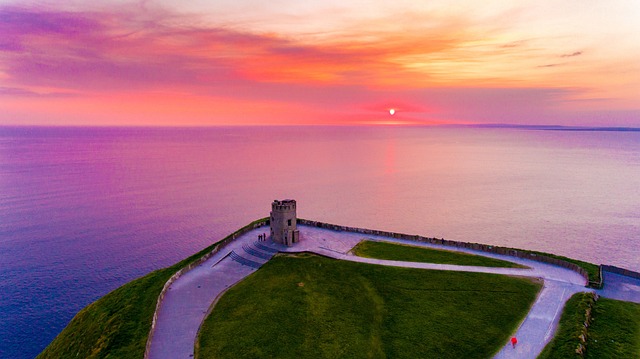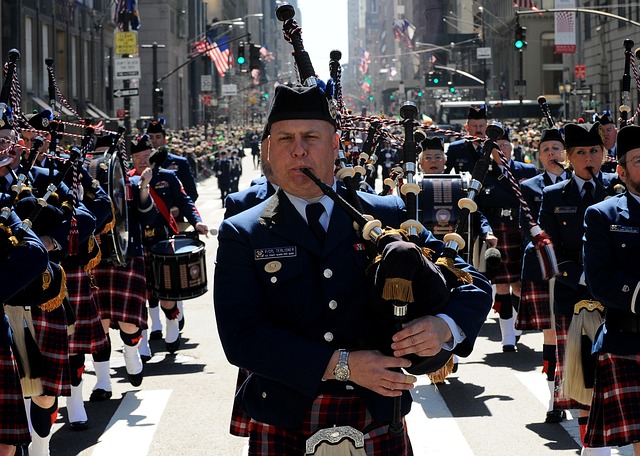The Irish American Flag is a powerful symbol that represents the vibrant heritage and struggles of Irish immigrants in America. With colors signifying beauty, purity, courage, and unity, it fosters a strong sense of belonging during parades and celebrations. Displayed at iconic locations and during events like St. Patrick's Day, the flag commemorates the resilience and contributions of Irish immigrants to American society, leaving an indelible mark on culture, cuisine, and politics. It serves as a testament to their heritage and an enduring symbol of pride for Irish Americans across the nation.
The Irish American Flag stands as a powerful symbol of heritage and resilience, representing the rich legacy of Irish immigrants in the United States. This article delves into the symbolism, history, and cultural importance of this iconic banner. From its design elements reflecting Ireland’s landscape and traditions to its role in modern celebrations, we explore how the Irish American Flag continues to unite and honor the diverse communities it represents. Discover the meaningful connections to historical events and locations that make this flag a true testament to Irish-American identity.
- The Symbolism Behind the Irish American Flag
- Historical Context: Ireland's Immigration to America
- Design Elements and Their Meanings
- Cultural Significance in Modern Times
- How the Flag is Displayed and Honored
- Iconic Locations and Events Associated with the Flag
The Symbolism Behind the Irish American Flag

The Irish American Flag, a vibrant display of green, white, and orange, holds profound symbolism for the significant Irish immigrant community in America. This flag is more than just a piece of fabric; it serves as a visual representation of their rich heritage, struggles, and triumphs. The colors themselves carry deep meaning: green symbolizing Ireland’s natural beauty and fertile land, white representing purity and peace, and orange embodying the courage and determination of Irish immigrants who faced adversity in their pursuit of a better life.
For Irish Americans, this flag often becomes a powerful tool for cultural expression and community bonding. It’s a symbol that fosters a sense of belonging, reminding them of their roots while celebrating their new home. During parades, celebrations, and various gatherings, the Irish American Flag unifies folks under a banner that reflects their shared history and resilience.
Historical Context: Ireland's Immigration to America

In the mid-19th century, a significant wave of Irish immigrants set sail for America, fleeing the Great Famine that devastated their homeland. This period marked a pivotal moment in the history of Irish Americans, as they sought new opportunities and a chance to rebuild their lives on foreign soil. The journey was arduous, but the promise of freedom from poverty and political oppression drove them forward. Many Irish immigrants settled in urban areas, particularly along the East Coast, where they contributed to the rapid growth and development of cities like New York, Boston, and Philadelphia.
The Irish American community soon became a vibrant part of American society, leaving an indelible mark on culture, cuisine, and politics. Their resilience and hard work were reflected in the construction of landmarks like the Brooklyn Bridge and the establishment of numerous churches and schools. The Irish American Flag, with its distinct design, serves as a powerful symbol of their heritage and the struggles they endured en route to building a new life in the land of opportunity.
Design Elements and Their Meanings

The Irish American Flag is more than a simple banner; it’s a powerful symbol of the rich heritage and enduring spirit of Irish immigrants in America. Each color and design element carries profound meaning, reflecting the struggles, triumphs, and cultural richness of this diaspora. The green represents the Emerald Isle itself, symbolizing Ireland’s natural beauty and its people’s resilience. White signifies purity and peace, recalling the aspirations for a better life that drove so many to cross the Atlantic. Orange echoes the color of the Irish land and its historic role in the country’s fight for independence, embodying courage and determination.
The design also incorporates elements that pay homage to American values. The stars on the flag represent the diverse communities of Irish Americans scattered across the nation, their unique stories weaving into the broader tapestry of American life. Together, these symbols tell a story of immigration, adaptation, and the unbreakable bonds forged between two nations united by history and shared values.
Cultural Significance in Modern Times

The Irish American Flag stands as a powerful symbol of the rich cultural legacy left by Irish immigrants in the United States. In modern times, it has evolved beyond its historical context to become an emblem of identity and pride for many Irish-Americans. The flag’s design, often featuring a tricolor pattern of green, white, and orange, carries deep meaning; green representing Ireland’s natural beauty, white symbolizing peace, and orange honoring the struggle for independence.
Today, this iconic banner is proudly displayed during cultural events, parades, and celebrations across America. It serves as a bridge connecting Irish Americans to their ancestral roots while also fostering a sense of community and belonging. The flag has become an integral part of the Irish-American tapestry, reflecting the resilience, determination, and vibrant culture that immigrants brought with them, leaving an indelible mark on the nation’s social and cultural landscape.
How the Flag is Displayed and Honored

The Irish American Flag, a vibrant symbol of heritage and pride, is prominently displayed across the United States, particularly on important occasions and in communities with strong Irish roots. This flag, designed to represent the unique identity of Irish immigrants and their descendants, is often seen as a powerful statement of cultural resilience and unity. It serves as a constant reminder of the sacrifices made by those who left Ireland’s shores in search of a better life, and the enduring legacy they’ve left behind.
Honoring this flag involves more than just its physical appearance; it’s about recognizing and celebrating the contributions of Irish Americans to American society. Whether flown at community events, displayed in historical museums, or raised during St. Patrick’s Day parades, the Irish American Flag fosters a sense of belonging and pride among those who trace their ancestry back to Ireland. Its vibrant colors and distinctive design resonate with folks, sparking conversations about history, heritage, and the enduring spirit of a people who have left an indelible mark on the American landscape.
Iconic Locations and Events Associated with the Flag

The Irish American Flag, a vibrant symbol, is inextricably tied to the rich history and cultural heritage of Irish immigrants in America. Iconic locations across the United States bear witness to its enduring legacy. For instance, the flag prominently adorns St. Patrick’s Cathedral in New York City, standing as a sentinel over the bustling metropolis that has long been a haven for Irish immigrants. This historic cathedral, with its magnificent architecture, serves as a tangible link to the past, reminding folks of the struggles and triumphs of early Irish settlers.
Moreover, significant events like St. Patrick’s Day parades across America are inseparable from the Irish American Flag. These vibrant celebrations, characterized by the dance and music that fill the streets, become living testaments to the Irish immigrant legacy. The flag, waved high with pride, resonates with stories of perseverance, cultural preservation, and the unbreakable spirit that has shaped so many lives. Each flap of the fabric tells a tale of hope, resilience, and the enduring connection between Ireland and its dispersed sons and daughters.
